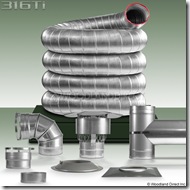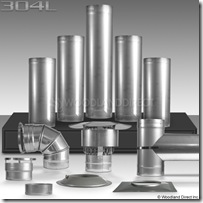Re-lining or lining your chimney may not seem like the easiest DIY project, but it really can be. A great reason for it to become a project on your to-do list is the important safety benefits that your home will realize.
There are many different reasons for lining or relining your chimney. Two of the most common reasons would be to repair a damaged or compromised chi

mney, or to connect a new heating appliance to an existing chimney. The causes for a damaged chimney could be from a chimney fire, your home settling, lightning, and even hurricanes.
Chimney relining is one of the most practical and affordable ways for you to repair a damaged or deteriorated chimney. Older chimneys may be unlined or their original clay tile liners may have deteriorated over time. Deteriorated or missing liners may allow smoke, creosote, or even condensation to seep through your chimney walls causing more extensive damage. In case of a chimney fire, cracked or missing liners provide easier access for the fire to spread to nearby combustibles.
Another reason you may want to reline is to prevent any creosote buildup in your chimney. Creosote buildup is more likely to occur when venting a woodstove or wood insert into an existing masonry chimney. Excessive creosote buildup puts your chimney at a higher risk for fire. Connecting a chimney liner from the heating appliance through the chimney provid

es a safe continuous passage way for the hot flue exhaust and helps protect the existing masonry chimney. If you are using a wood burning or multi-fuel stove, lining your chimney will create a continuous smooth area with fewer surfaces for soot and tar to stick too. Any tar that does form on the walls of the liner can flow directly back to the stove and be re-combusted instead of building up in the crevices of a masonry chimney.
When relining your chimney it is important that you properly insulate the chimney liner. By insulating the liner, you will help keep the temperature of the flue gases hot, improving the draw of the chimney since warm air rises. Also, in most cases a liner will need to be insulated to retain its rating as a UL listed liner system. Insulation is provided with most relining systems.
A new
chimney liner is an effective way to keep carbon monoxide, moisture, smoke, creosote, and other products of combustion from seeping through the bricks and mortar of your existing chimney and leaking into your home. As you can see, a secure lining system is an important part of a safe and functional chimney system.
 Our triple-wall chimney systems exceed chimney standards and can be installed by the homeowner or uncertified installer. Triple-wall systems are dependable and protected with a lifetime warranty. These systems may be used with a variety of stoves and fireplaces, including wood stoves, furnaces, boilers, stoves, ranges, water heaters, or other appliances fueled by wood, oil, coal, or gas. These systems offer an additional 2" clearance of air space, which guarantees the fire code clearances. This design will also stay cool on the outside and provide a hot draft on the inside, boosting efficiency and providing for a fire-safe design that protects both the chimney and the building. The triple-wall chimney features two insulating layers, a ceramic blanket and air space to eliminate hot spots. Not only is this a safe option, but you also can save money by not having to pay an installer.
Our triple-wall chimney systems exceed chimney standards and can be installed by the homeowner or uncertified installer. Triple-wall systems are dependable and protected with a lifetime warranty. These systems may be used with a variety of stoves and fireplaces, including wood stoves, furnaces, boilers, stoves, ranges, water heaters, or other appliances fueled by wood, oil, coal, or gas. These systems offer an additional 2" clearance of air space, which guarantees the fire code clearances. This design will also stay cool on the outside and provide a hot draft on the inside, boosting efficiency and providing for a fire-safe design that protects both the chimney and the building. The triple-wall chimney features two insulating layers, a ceramic blanket and air space to eliminate hot spots. Not only is this a safe option, but you also can save money by not having to pay an installer.  Our professional chimney systems are a double-wall system and meet all chimney standards. The big difference between these and the triple-wall systems is that double-wall systems must be installed by a professional. With professional installation, this product is also backed by a lifetime warranty. Triple-wall systems are all-fuel chimney systems. They may be used with wood stoves, fireplaces, furnaces, boilers, ranges, water heaters, or other appliances fueled by wood, oil, coal or gas and zero-clearance fireplaces that are factory-built. Our professional systems feature lightweight insulation, twist-lock fittings, support boxes with factory installed starter sections, elbows with 360° swivel base, select black finish pipe lengths, and five foot length pipe sections. The sleek 1" wall design ensures optimum safety and performance, keeping the outer wall of the chimney cool and the flue gas temperature high for superior draft performance. The double-wall option can be the more cost effective of the two if you are planning on hiring a professional to install your chimney system.
Our professional chimney systems are a double-wall system and meet all chimney standards. The big difference between these and the triple-wall systems is that double-wall systems must be installed by a professional. With professional installation, this product is also backed by a lifetime warranty. Triple-wall systems are all-fuel chimney systems. They may be used with wood stoves, fireplaces, furnaces, boilers, ranges, water heaters, or other appliances fueled by wood, oil, coal or gas and zero-clearance fireplaces that are factory-built. Our professional systems feature lightweight insulation, twist-lock fittings, support boxes with factory installed starter sections, elbows with 360° swivel base, select black finish pipe lengths, and five foot length pipe sections. The sleek 1" wall design ensures optimum safety and performance, keeping the outer wall of the chimney cool and the flue gas temperature high for superior draft performance. The double-wall option can be the more cost effective of the two if you are planning on hiring a professional to install your chimney system.





